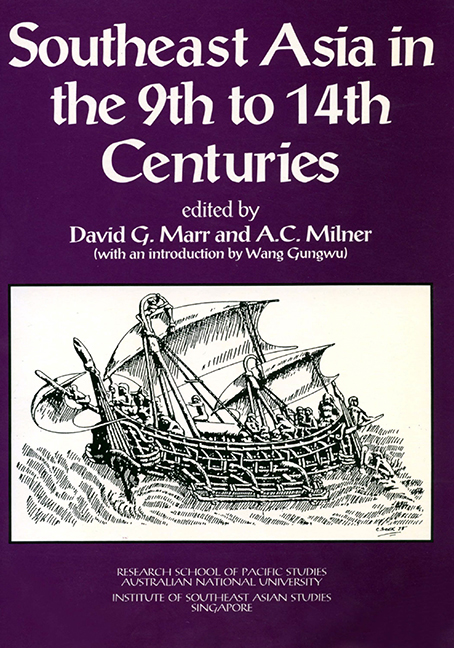Book contents
- Frontmatter
- Contents
- Contributors
- Preface
- Introduction
- 1 The Early and the Imperial Kingdom in Southeast Asian History
- 2 Hydraulic Works and South East Asian Polities
- 3 Some Notes on Relations between Central and Local Government in Ancient Java
- 4 Negara, Mandala, and Despotic State: Images of Early Java
- 5 Some Remarks on Early State Formation in Cambodia
- 6 “Elephants Can Actually Swim”: Contemporary Chinese Views of Late Ly Dai Viet
- 7 Authority and Legitimacy in 11th Century Vietnam
- 8 From Myth to History: Imagined Polities in 14th Century Vietnam
- 9 Shipshape Societies: Boat Symbolism and Political Systems in Insular Southeast Asia
- 10 Changing Perspectives in Island Southeast Asia
- 11 Political and Cultural Continuities at Dvaravati Sites
- 12 The True and the Corbel Arch in Mainland Southeast Asian Monumental Architecture
- 13 Vietnamese Ceramics and Cultural Identity: Evidence from the Ly and Tran Dynasties
- 14 Traditions, Acculturation, Renovation: The Evolutional Pattern of Vietnamese Culture
- 15 Symbolism of Kingship in Arakan
- 16 Buddhism in Champa
- 17 The Ordering of Generations: Change and Continuity in Old Javanese Kinship
- 18 Sources on Economic Activities in Khmer and Cham Lands
- 19 Narrative Bas-Reliefs at Candi Surawana
- 20 Possibilities for a Reading of the 1293-1357 Period in the Vietnamese Annals
- Index
- Miscellaneous Endmatter
10 - Changing Perspectives in Island Southeast Asia
Published online by Cambridge University Press: 21 October 2015
- Frontmatter
- Contents
- Contributors
- Preface
- Introduction
- 1 The Early and the Imperial Kingdom in Southeast Asian History
- 2 Hydraulic Works and South East Asian Polities
- 3 Some Notes on Relations between Central and Local Government in Ancient Java
- 4 Negara, Mandala, and Despotic State: Images of Early Java
- 5 Some Remarks on Early State Formation in Cambodia
- 6 “Elephants Can Actually Swim”: Contemporary Chinese Views of Late Ly Dai Viet
- 7 Authority and Legitimacy in 11th Century Vietnam
- 8 From Myth to History: Imagined Polities in 14th Century Vietnam
- 9 Shipshape Societies: Boat Symbolism and Political Systems in Insular Southeast Asia
- 10 Changing Perspectives in Island Southeast Asia
- 11 Political and Cultural Continuities at Dvaravati Sites
- 12 The True and the Corbel Arch in Mainland Southeast Asian Monumental Architecture
- 13 Vietnamese Ceramics and Cultural Identity: Evidence from the Ly and Tran Dynasties
- 14 Traditions, Acculturation, Renovation: The Evolutional Pattern of Vietnamese Culture
- 15 Symbolism of Kingship in Arakan
- 16 Buddhism in Champa
- 17 The Ordering of Generations: Change and Continuity in Old Javanese Kinship
- 18 Sources on Economic Activities in Khmer and Cham Lands
- 19 Narrative Bas-Reliefs at Candi Surawana
- 20 Possibilities for a Reading of the 1293-1357 Period in the Vietnamese Annals
- Index
- Miscellaneous Endmatter
Summary
The eastern and southern boundaries of modern Southeast Asia, or rather of the nation-states of which the modern region is comprised, are easily defined. From the Pacific Ocean in the north, an agreed line runs through the centre of New Guinea, across the Arafura and Timor Seas (with a short section yet to be determined) and into the Indian Ocean on the west. Like so many other national boundaries, these limits reflect colonial activities, especially in the first half of this century. To some extent, they seem also to follow the physical geography, though in Irian Jaya and the Aru Islands Indonesia extends beyond the Sunda shelf and intermediate area of Wallacea into areas which, geographicallyspeaking, belong with other Sahul territories. Similarly, historical links explain the association of neighbouring oceanic islands in the western Pacific with the USA and in the Indian Ocean with Australia.
It is not at all remarkable that these political boundaries and, to a large extent, the categories within which so many other ways of thinking are formed should be determined by such historical circumstances. In the same way, for this southeastern area in the period from the ninth to the fourteenth centuries, beyond the Indian and Chinese influences so important in the northern and western parts of modern Southeast Asia, even older processes may have contributed to cultural patterns. In island Southeast Asia, enough is now known of the late prehistory of the region - say, the last few millennia - for the later effects of the events of that period to be traced with some certainty. The most important of these prehistoric processes was the movement of people speaking Austronesian languages.
This knowledge is comparatively new, and it is of some interest to understand the reasons why this should be the case. The systematic study of prehistory in northern Europe arose only in the nineteenth century and it was not until the 1920s and 1930s that Gordon Childe was able to put together a convincing general account of the transition across Europe from hunting to farming, and of later developments. In Southeast Asia, the various late colonial administrations gradually developed effective museums and antiquities services, though the structural remains from the mid-first millennium AD onwards and, on Java, the search for early man consumed much of the effort.
- Type
- Chapter
- Information
- Southeast Asia in the 9th to 14th Centuries , pp. 215 - 228Publisher: ISEAS–Yusof Ishak InstitutePrint publication year: 1986



